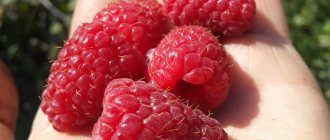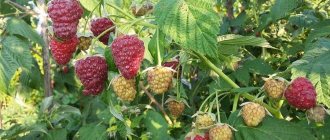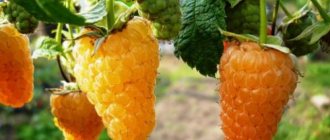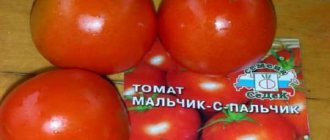The “heroine” of our article today, the large-fruited raspberry “Patricia,” not only won the sympathy of a significant number of Russian gardeners, but, like other plants of this type, became the cause of numerous disputes and caused serious criticism.
Raspberry “Patricia” is a fairly well-known large-fruited variety that has earned very mixed reviews from gardeners
We will try to give readers a complete understanding of the real qualities of this plant, its advantages, disadvantages and features of cultivation in summer cottages. Let's start by looking at the main characteristics:
| Parameter | Characteristic |
| Culture | Garden raspberry (Rubus idaeus L.) |
| Fruiting | One-time (non-repairable) |
| Ripening time | Early |
| Productivity | High: on average 4-5 kg per bush (maximum - up to 8 kg) |
| Berries | Large (weighing from 8-12 g to 14 g), elongated conical shape, dark crimson color, with small seeds |
| Pulp | Tender, sweet and sour, aromatic |
| Tasting assessment | 4-4.2 points (out of 5) |
| Purpose of berries | Dessert, suitable for all types of processing |
| Features of the plant | The bushes are compact, the stems are straight, practically devoid of thorns. The leaves are large, light green, flat. Fruit branches are strong, long, located along the entire length of the stems |
| Shoot formation activity | Average |
| Sustainability | Winter hardiness and drought resistance are average; susceptibility to diseases is weak, susceptible to damage by insect pests |
| Cultivation technology | Requires intensive agricultural technology: abundant watering and spraying leaves with water (especially in the heat), regular dosed fertilizing; tying fruiting shoots to supports, bending them down and covering them for the winter |
| Recommended growing regions | Temperate climate |
| Registration in the Federal State Budgetary Institution "State Varietation Commission" | Turned off |
History and description of Patricia raspberries
As you gobble up sweet raspberries on both cheeks, sometimes you don’t even think about the origin of your favorite variety. But Patricia’s story is very interesting. Large-fruited raspberries first appeared in England. The carrier of the gene was a bush of the Molling Jewel variety, popular on the island and in Western Europe. And breeder Derek Jennings saw the unusually large berries.
Over time, large-fruited raspberry varieties were created based on this genetic trait. Work in this direction was also carried out in the USSR. Viktor Kichina, who worked at the All-Russian Selection and Technology Institute of Horticulture and Nursery Growing, in 1986 conducted an experiment on crossing the domestic variety Maroseyka and donor M102. The resulting samples were selected and numbered K55 in 1989. And only in 1992, as a result of reproduction, the Patricia variety was born.
The Patricia variety is large-fruited, individual berries can grow up to 4 cm
An adult Patricia bush grows up to 1.8 m. The plant is erect and spreading. There are from 6 to 10 shoots replacing fruit-bearing and dead branches. On average, there are about 6 root shoots. Straight shoots are slightly pubescent and covered with a waxy coating to a small or medium extent. A distinctive feature of Patricia raspberries is the absence of thorns. The elongated and well-developed fruit branches are quite strong. On the 2–4 branches they have, up to 20 large fruits are formed.
Patricia raspberry bushes are tall and spreading, the shoots are devoid of thorns
The leaf blade is medium to large in size. The surface is slightly wrinkled, almost hairless. The light green leaf is topped with a crenate edge. Young leaves are colored red-brown.
Patricia's fruits are conical in shape; even among large-fruited varieties, they stand out in both weight and size. One berry can grow up to 4 cm in length and weigh 11–12 g, but the average weight is 7–10 g. The surface of the fruit is velvety, colored bright red with a hint of crimson. Small and uniform drupes are tightly connected to each other, due to which the ripe berry is removed from the stalk entirely. The seeds are few and very small. Patricia fruits are dessert fruits. The pulp is juicy, melts in your mouth and sweet. The berries have a wonderful raspberry aroma.
The taste qualities of Patricia raspberries are rated very highly by tasters - 4.6–5 points.
Features of the plant and specifics of cultivation
Raspberries are non-repairing, medium-sized (up to 180 cm). The bushes are compact, the stems are straight, practically devoid of thorns. The activity of shoot formation is average: each plant annually produces about 7 root shoots and 6-10 new stems (replacement shoots). The leaves are large, light green, flat. Fruit branches are strong, long, located along the entire length of the stems. Each can produce up to 20 berries.
Early ripening fruits: in the middle zone, harvesting begins in the first ten days of July. During 3-4 weeks of fruiting, at least five harvests are required. The berries have a beautiful elongated conical shape, dark crimson color, dense, large, weighing on average 8-12 g, but they can weigh up to 14 g. The taste is sweet, the aroma is “classic” raspberry. The seeds are small, almost unnoticeable when eaten fresh. The fruits are perfect for homemade preparations. The productivity of the variety is assessed as high. According to the author, the average yield per bush is 4-5 kg, but under favorable weather conditions and active fertilizing, this parameter can be doubled.
Despite the abundance of positive qualities, the Patricia variety is not without its drawbacks. It is important to mention these features:
- quite attractive to insect pests (especially gall midges and raspberry flies). In general, the variety lives up to the author’s promises in terms of resistance to disease, but according to reports from summer residents, ripe fruits left on the bushes in wet summers tend to develop rot, which is quickly transmitted to neighboring, not yet ripened berries, and can destroy a significant part of the crop;
- strong dependence on the activity of agrotechnical measures. With insufficient care, Patricia raspberries immediately show a decrease in productivity and fruit quality;
- limited cultivation area. The author recommends the variety for cultivation throughout the country, but, according to reviews, the Patricia raspberry feels quite good only in a temperate climate. Despite the declared “winter hardiness,” in regions with long, cold winters, plants need to be bent down and shelters constructed to avoid freezing of fruit-bearing shoots. In areas with hot, dry summers, the variety requires extremely abundant watering. At the same time, organizing drip systems does not help: the upper parts of the shoots still dry out. Bushes need not only moisture supply under the roots, but also frequent spraying of water on the leaves;
- the need to construct “multi-tiered” trellises. The shoots of "Patricia" are not very durable. They often bend under the weight of the berries and may even break off. Therefore, the stems must be tied up, each in 2-3 places;
- the formation of curved and “double” berries (especially at the very beginning of fruiting). Some summer residents see the reason for this phenomenon in the high nitrogen content in the soil (for example, with too active application of organic fertilizers) or in the “vags” of the weather. There is another opinion: with a high risk of misgrading, gardeners often sell “Maroseyka” raspberry material, which has similar parameters and precisely this fruiting feature, instead of “Patricia” seedlings;
- unsuitability of fruits for freezing, storage and transportation. The delicate consistency of the pulp in this case is more of a disadvantage than an advantage. When defrosted, the berries “flow” and lose their shape; they quickly become wrinkled during transportation. In an effort to preserve the harvest, some gardeners remove some of the fruits, cutting them off the branches along with the stalks in order to bring them back from the site undamaged.
Characteristics of the variety
- Patricia's early fruitfulness is beyond praise: already in the second year after planting, you can taste the berries.
- The variety is not remontant, but the fruiting period is surprising in duration. The harvest can be harvested already in the first ten days of June, and the harvest period ends only in mid-August.
- Fruiting occurs on last year's shoots. The yield is high - on average up to 5 kg per bush. With proper care, Patricia can produce 8 or even 11 kg of berries from one plant. In the first 2 years, the variety will not be able to show all its capabilities. Peak fruiting is achieved starting at 3 years of age and can continue up to 10 years of age.
- The variety is suitable for cultivation not only in the southern regions. The climate of central Russia, including the Moscow region, also perfectly meets the plant’s requirements. Patricia can withstand temperatures of -30 °C well, while ordinary varieties can freeze out already at -15 °C. Raspberries are also tolerant of high temperatures.
- Possessing excellent immunity, the variety resists anthracnose, didimella and botrytis. But the plant copes poorly with late blight, so it is necessary to regularly prevent this disease. Among the pests, this variety is too tough for the raspberry shoot aphid.
- Patricia's large and beautiful berries do not tolerate transportation very well. They lose their shape very quickly due to their not too dense consistency.
Patricia has a long fruiting period - from early June to mid-August
Table: advantages and disadvantages of the variety
| Advantages | Flaws |
| Large fruit and high yield | Low level of transportability |
| Excellent taste | Tall plant requires staking |
| Excellent frost resistance | Berries can rot if exposed to excess moisture. |
| High temperature tolerance | |
| Strong immunity | |
| Long-term fruiting | |
| Lack of thorns makes harvesting easier |
Key advantages and disadvantages
The Patricia variety is famous for its frost resistance and excellent berry quality.
Patricia has many advantages, thanks to which it has appealed to gardeners in many regions. But there are also some disadvantages that you should know about before purchasing seedlings. Let's consider all aspects in more detail.
Table: positive and negative qualities of raspberries
| Advantages | Flaws |
| High productivity (up to 11 kg per bush) | The tendency of berries to deform |
| Frost resistance | Low transportability |
| Good taste and large berry size | A large amount of growth |
| A small number of seeds, which allows the berries to be used for decorating confectionery products | Predisposition of berries to rot at high humidity |
| Resistance to raspberry aphids and leaf scorching | The need to tie up shoots, which are often broken by the weight of the fruit |
| When ripe, the berries do not fall off for several weeks | Large seeds |
| Lack of thorns on the stems |
Landing Features
If you follow all the planting rules and choose healthy planting material, raspberries will quickly take root in a new place and will delight you with the harvest.
Selecting a location
The abundance of sunlight does not scare Patricia raspberries. Its leaves are not subject to burning. Good lighting will benefit the harvest; the maximum amount of sugars will form in the berries. Rows planted from north to south will receive even sunlight. If raspberries are in dense shade, this will immediately affect not only the appearance of the plant, but also the taste of the berries. The shoots will be elongated, and the fruits will not please you with either size or taste.
Wind protection is a must in winter. Bushes growing in windy areas dry out very quickly. To prevent this, raspberries should be planted in places covered from the north by buildings or densely planted ornamental bushes.
Patricia raspberries should be planted in a sunny place, but protected from the wind.
For raspberries, it is important that the soil is rich in humus, has a loose structure and water permeability. Patricia will grow and bear fruit well on loams and sandstones. Saline, heavy clay, highly carbonate and swampy soils are not suitable for growing raspberries. In unsuitable areas, bushes are planted in high beds. But they have a significant drawback - they dry out very quickly. Therefore, such plantings need to be given increased attention.
Despite all the love for watering, Patricia’s root system is very sensitive to stagnant water. It is important that the groundwater level does not lie closer than 1–1.5 m to the surface.
Deadlines
The most acceptable planting dates fall at the end of August - mid-September, but no later than 2-3 weeks before the onset of stable frosts. During a fairly warm and humid autumn, the seedling will have time to take root. Regions with a temperate climate, that is, those located in the south, have such favorable conditions. Plants planted in the fall will delight you with rapid growth in the spring, the process of which will begin earlier than with spring plantings.
When planting in autumn, raspberry stems must be covered with soil to a height of up to 12 cm so that the growth buds do not freeze in winter.
Spring planting is also acceptable. But it is best carried out in regions where the spring is wet and long. Spring planting should take place quickly before the juices begin to flow in the stems.
When choosing a planting date for Patricia raspberries, you need to take into account the fact that the variety may not take root well on insufficiently moist soils. Therefore, plant raspberries exactly when the weather in your region suits the requirements of the plant.
Planting material
The future abundance of sweet berries directly depends on the correctly selected planting material. It is best to buy seedlings in specialized nurseries. In them you will not only purchase the desired variety, but also receive the necessary advice.
Rate the seedlings you like based on the following parameters:
- Stem. It is very good when the bush has several formed stems. This indicates that the seedling is viable and ready for active growth. The bark on the shoots should be intact and not dry.
- Root system. Well-developed roots, without damage, rotten or torn areas, are the main indicator of the health of the seedling.
- Kidneys. At least 3 growth buds at the base of the shoot. It is from them that branches will develop.
- Package. This point is no less important, as it will prevent the root system from drying out.
The root system of seedlings must be well developed and without damage
Preparatory work on the site
If you decide to plant a raspberry tree, then the site for it needs to be prepared 2 years before planting. On fertile soils of suitable structure, the plant will be able to produce good yields within 10–12 years.
It’s a good idea to keep the soil under black fallow - dig it thoroughly, select the roots of perennials and not sow anything. In this form, the earth is able to restore biochemical processes and physical characteristics.
The selected area can be sown with green manure. These plants will displace weeds from the site, enrich the soil with useful elements and improve the structure. To prevent green fertilizer from becoming a weed, you need to mow it before flowering begins. For sowing, clover, mustard, cereals, and cruciferous crops are used. If you do not use green manure, in the fall you need to add a sufficient amount of manure for deep digging - up to 2-3 buckets per 1 m2. You can add complex mineral fertilizers to organic matter - Kemira Universal, Stimul, Rost - 1 cup.
Green manure sown before planting raspberries will perfectly prepare the soil
What else you need to know before planting raspberries:
- Bushes will not grow in acidic soils, so take care of adding fluff lime in advance.
- Good neighbors for raspberries are pears, apple trees and plums, but the proximity to cherries is unfavorable.
- Planting too close to black currants, sea buckthorn and strawberries may turn out to be a failure.
- Among vegetable crops, tomatoes, potatoes and eggplants are bad predecessors.
- The place where the raspberries grew should rest for at least 5 years before planting a new berry garden.
Planting raspberries
When planting the Patricia variety, you need to remember the tallness of the bushes. Closely and frequently planted plants will shade each other, which will reduce the quantity and quality of the harvest. Therefore, in popular strip plantings, the distance between bushes should be at least 70 cm. Row spacing is left wider - up to 1.5 m.
Planting of seedlings is carried out as follows:
- The fibrous root system of the seedling measures about 20 cm, so the planting hole should be 40 cm in diameter and depth.
- Before planting, the roots of the seedling are soaked for 2 hours, but no more. You can add Kornevin or Heteroauxin to the water.
- If fertilizers were not applied during digging in the fall, then humus and mineral additives are added to the holes and mixed well with the soil.
- A small mound is built from the soil mixture at the bottom of the depression, on which the seedling is placed. The roots need to be straightened.
- Then the seedling is covered with soil, shaking the top slightly so that the soil is distributed between the roots without leaving empty spaces. Plants are planted at the same depth at which they grew before.
- After planting, the soil around the bush is compacted, a watering circle is made and 5 liters of water are poured into it.
- After the water has been completely absorbed, the plantings are mulched. This will prevent excessive drying of the soil, which can be disastrous for the seedling.
Video: planting raspberries in autumn
Recommendations for cultivation
It is recommended to purchase seedlings from specialized nurseries. Only high-quality varietal seedlings guarantee a healthy, strong and high-yielding plant.
Raspberries of the Patricia variety must be cultivated according to the recommended technology for growing berry bushes. It can be planted in holes or trenches.
The process of planting the Patricia variety
When planting, be sure to include:
- humus or compost,
- granulated superphosphate,
- potassium sulfate or wood ash.
Dig a hole of the required depth. Its dimensions are selected individually for the root system of the bush.
The seedling is carefully laid on the bottom, straightening the roots. They should not be enclosed or bent under any circumstances. The root collar is deepened by about 2 or 3 centimeters.
Then the seedling is covered with soil and compacted a little. There is no need to trample down the soil too much; it should remain loose.
A hole is made around the bush, into which at least 7 liters of clean water are poured.
After this, the soil can be mulched and kept moist until young shoots appear.
Raspberry care
Patricia is much easier to care for than remontant varieties. But even simple raspberries need good supervision.
Watering
In order for raspberries to delight with juicy fruits, they need high-quality watering. But the plant does not like excessive moisture. Even short-term stagnation of water in the roots can cause their death.
During the period of ovary formation, growth and ripening of berries, the soil in the raspberry garden should be in a moderately moist state, but nothing more. It is quite easy to control the level of soil moisture. You need to take a handful of earth from a depth of 15 cm and squeeze it in your hand. If the resulting lump does not fall apart, then there is no need for watering yet.
Raspberry roots are located shallow and cannot extract moisture from the lower layer of soil. Therefore, watering must be of high quality, capable of saturating the soil with moisture to a depth of 40 cm. Up to 10 liters of water are used per 1 m2 of raspberry bush. During the ripening period, the amount of moisture doubles.
To prevent water from wastingly spreading on the surface, shallow grooves are dug on both sides of the planting, where watering is carried out. After moisture is absorbed, the grooves are covered with dry soil. He really likes the plant and the sprinkling method. It is better to do it in the evening so that drops of water do not cause sunburn on the leaves.
If at the end of autumn the weather is hot with insufficient rainfall, then the raspberries need to be watered generously. Plant tissues saturated with moisture ripen faster and are more resistant to frost. This must be taken into account if the raspberry patch is located on sandstones. Clay soils, on the contrary, are not recommended to be flooded.
On large raspberry plantations, it is convenient to use drip irrigation, in which moisture is delivered directly to the roots
Seedlings, especially those planted in spring, must be under strict control. If the delicate root system of a young plant experiences a lack of moisture or an excess of it, the plant may die.
Mulch will help maintain the required level of moisture in the soil and prevent weed growth. It is used immediately after planting and throughout the growing season. Old mulch should be periodically replaced with new one.
Top dressing
You need to be careful with nitrogen-containing fertilizers - urea, ammonium sulfate, ammonium nitrate, phosphorus-containing superphosphate acidify the soil, which Patricia does not at all welcome. But you can’t completely leave raspberries without feeding; this immediately affects the quality of the crop.
Recent Entries
Lilac perennials that are beautiful, compact and do not crowd out other plants Why when buying seedlings you should not take the sellers’ word for it and how to determine the age of the plant using 3 signs Tomato seedlings have turned purple or whitish: why the color has changed and how to save the plants
A good alternative to mineral fertilizers is organic matter, which contains almost the entire range of useful substances.
- Rabbit or goat droppings, as well as manure, are diluted with water in a ratio of 1/10. Bird droppings should be diluted with water 2 times more - 1/20.
- Perfectly nourishes raspberries and green manure. It's very easy to make. You need to fill the container (bucket or barrel) with chopped weeds and plant tops about halfway. Fill with water to the brim and cover with a lid, but not too tightly so that gases escape during the fermentation process. After a few days, the mass will begin to bubble and then acquire a characteristic odor. The finished concentrate will have a brownish-brown color, and foaming will stop. To prepare the working solution, you need to dilute 1 liter of concentrate in 10 liters of water.
Compost and green fertilizer made with your own hands will perfectly feed raspberries.
In total, up to 3 feedings are made during the growing season:
- spring (April);
- before flowering;
- in the fall after pruning.
If raspberries are delayed in growth, you can add a little nitrogen to the organic matter in the form of urea or ammonium nitrate - 15 g per 1 m2.
To avoid burning the roots, apply liquid fertilizer to raspberries only after the soil has been moistened.
Trimming
Experienced gardeners are well aware of the peculiarity of the Patricia raspberry. Its two-year-old branches that bear fruit dry out and die. They need to be trimmed, preferably close to the ground, so that there are no stumps left. Along with the dry ones, you also need to cut out weak, undeveloped shoots. It is best to burn the removed material to prevent the spread of accumulated pathogens and pests.
After normalizing the shoots, the raspberry bush should consist of no more than 8 branches. Then the remaining shoots will have enough space and light for optimal development and fruiting next year.
In the spring, inspect the raspberry tree again and carry out the final standardization procedure, removing broken or dried stems.
To increase the yield and quality of berries, in the spring (before the onset of sap flow), the ends of the shoots are shortened at a height of 1 to 1.5 m. Side shoots up to 30 cm or more in length are formed from the remaining buds. Due to this, the fruiting period is also extended.
Video: pruning raspberries after fruiting
Garter
Due to the high yield and large size of the berries, Patricia's long branches may become overloaded and break. In addition, caring for untied raspberries becomes difficult, and the quality of the berries decreases sharply. Dense plantings are more often exposed to diseases and pest attacks. To prevent this from happening, the bushes need to be tied up.
Tied raspberry bushes look very neat and are easy to care for.
The simplest and most common is the trellis method. By the way, it is also the most effective. You will need support posts (can be iron or wood) 2 m long and wire with a diameter of 5 mm. The posts are driven along a row of bushes every 3 m. A wire is stretched between them in 3 rows: at a height of 0.75, 1.0 and 1.6 m. The raspberry bush is fixed on a trellis, starting from the lower shoots. For tying, it is best to use natural material so as not to damage the bark of the branches.
Video: making a trellis yourself
Winter shelter
The good resistance of well-groomed Patricia to frost has already been mentioned. But sometimes the raspberry patch is located in very windy areas or the winters are frosty, with sudden temperature changes and little snow. To prevent shoots from freezing, it is better to play it safe.
Preparing raspberries for winter is easy. In October, when the branches are still quite flexible, 2 bushes are tilted towards each other and tied at a height of 30–40 cm from the soil surface. First, the bush is tied in the middle, and then its top is secured to the base of the neighboring bush. Raspberries tolerate winter well under natural cover - snow cover. If there is none, you can cover the bent bushes with spruce branches or covering material.
You can't bend too low. This can break off the shoot at the base.
In spring, do not rush to tie raspberries to the trellis. The branches are still very fragile and can break easily. Untie the bushes when the air temperature rises above +8 °C. As soon as the process of sap flow begins in the plants, they will straighten themselves. After this, they can be safely tied up.
Video: how to tie the stems correctly
Growing and care
Watering
Waterlogged soil leads to rotting of the berries of this raspberry variety. Therefore, watering must be controlled and carried out as the soil dries out. It must be remembered that before applying fertilizer, the raspberry tree is watered in any case.
Trimming
In Patricia raspberries, only fruit-bearing branches are pruned in late autumn. Young shoots are left for the next season. In early spring, when inspecting the bushes, you need to remove dry, frozen, thin stems and trim off the tops of healthy ones. In summer, branches are cut to the level of the trellis, and excess young shoots are also removed if there are more than 5-7 of them. This is how the bush is thinned out so that there is no shadow in the raspberry patch.
Attaching branches to trellises is mandatory. Under the weight of massive berry clusters, they bend and break; on low shoots, the berries often touch the ground. The garter also promotes good lighting and ventilation of the bushes.
Top dressing
Young raspberries begin to be fed at the age of 3-4, since the weak root system is not capable of receiving much nutrition, unless, of course, the soil was loaded with fertilizers before planting. In spring, raspberries need nitrogen fertilizers to stimulate the green mass of the bush; before flowering and the berries begin to ripen, the plant needs minerals: potassium, superphosphate, wood ash. It is also necessary to add compost and herbal infusions. In late fall, you can spread cow, pig, or horse manure. It will rot over the winter, and it will come in handy in the spring.
Preparing for winter
Given the good frost resistance of the variety, gardeners bend and cover only the lower part of the bush. If frosts in the region are below 35 degrees, then all branches must be removed from the trellises and bent to the ground to be covered with snow in winter.
Reproduction
It is easier to grow Patricia raspberries by shoots. The bush produces a sufficient number of root shoots. They can be separated from the mother bush along with a lump of earth and transplanted into pre-prepared holes.
Diseases and pests of Patricia
Despite the excellent health of the variety, unkempt plantings often become targets of pest attacks and are affected by diseases.
Table: pests, diseases and control measures
| Diseases and pests | Characteristic symptoms | Control measures | Prevention |
| Late blight (root rot) | With frequent waterlogging of the soil, the root system rots. Then the lower part of the branch begins to darken. The tissue in the affected part is destroyed. |
|
|
| Gray rot | The first signs of the disease may appear at the initial stage of fruit ripening. Brown spots appear where the berries touch. The fungus then completely covers the fruit, making it unfit for consumption. | The disease must be combated with the help of fungicides - Ronilan, Fundazol or Rovral. The drugs are used only in accordance with the instructions. |
|
| Septoria | At the initial stage of the infection, the leaves become covered with small brown spots. Then they turn white, with a purple border appearing around them. The disease can also affect shoots, after which they die. | Before the buds begin to bloom, treat the plant with Nitrafen or a 0.5% solution of copper oxychloride. |
|
| Raspberry fly | The pest, which hibernates under the bush, begins to lay eggs in the leaves of the apical shoots in May. The developed larva penetrates the stem, which leads to withering of the shoot. |
|
|
| Raspberry beetle | The pest feeds on leaf and flower buds. The beetle lays its larva inside the fruit, where it develops. The berry does not grow, begins to wither and rot. | Fitoverm and Agravertin will help cope with the problem. Prepare the solution strictly according to the instructions. |
|
| White leafhopper | It feeds on sap by making holes on the surface of the leaf. At the puncture site, light spots form, which merge into large affected areas. In a weakened plant, immunity decreases and raspberries become susceptible to fungal infections. |
|
|
Photo gallery: diseases and pests of raspberries
Phytophthora affects roots and branches
Gray mold spreads very quickly in wet weather
When infected with septoria, characteristic spots appear on the leaves - white, bordered by purple borders.
The raspberry fly larva causes the shoot to wither
The raspberry beetle eats the buds, and the larva eats the berries
White leafhopper weakens raspberries, making them vulnerable to fungal diseases
Shelter for the winter
To prevent frostbite in the shoots during the winter season, they must be properly covered. Sawdust is scattered on the soil around the bushes in a layer of up to 15 cm. A wire is pulled along the bushes at a level of 20–30 cm from the ground.
The shoots are carefully tilted and tied to it with nylon thread. Cover the top with special garden material or roofing felt.
More on the topic: A complete description of the differences between raspberries of different colors
You can protect the bushes from cold winds with a wall made of slate or plywood; using oilcloth is not recommended. During snowy winters, it is necessary to ensure that the bushes are evenly covered with a snow cap.
If an ice crust forms as a result of a sudden thaw, holes should be made along the row or around the bush for air access.
How to collect and preserve the harvest
Patricia raspberries are harvested as they ripen. Collection should only be done in dry weather. Even a slightly damp berry will quickly become moldy. There is no need to rush into harvesting; the fruits are held quite tenaciously on the stalk. But there is no need to tighten it either; raspberries that are too overripe lose their shape and quickly drain.
It will not be possible to transport crops over long distances. The pulp, which has a loose, delicate consistency, quickly releases juice. To avoid this, it is recommended to pick the berries with the stalk. In this form, the fruits can remain in the refrigerator for 2-3 days without spoiling.
If raspberries are picked with the stalk, their shelf life will increase.
When harvesting, the fruits are immediately sorted. Whole ones are placed in small containers in a thin layer, the crumpled berries are immediately processed. Raspberry Patricia is universal. Aromatic preserves and jam are prepared from it. In addition to traditional preparations, you can experiment with berries. For example, prepare marshmallows, confiture or marmalade. And in combination with other berries, you get an excellent flavor mix that will be filled with bright summer notes.
Raspberries, in addition to their excellent taste and aroma, also have healing qualities. Grated with sugar, it will serve as an excellent remedy for colds. For the same purposes, the berries can be dried and medicinal teas brewed.
You can make not only traditional jam from raspberries, but also unusual marshmallows
Reviews from gardeners
Oleg, 39 years old, Skopin
Of all the large-fruited varieties that I have tried, this is the most delicious. The yield is also good! Even in a not very successful summer, I never got less than 3 kg from a bush. But it also requires a lot of work: pruning fruit-bearing stems in the fall, gartering in the summer, removing shoots, etc. You need to “feed” regularly, but carefully - plants are sensitive to both a lack of nutrition and its excess. This also applies to humidity. In damp summers the berries turn out watery, but in dry summers the bushes suffer very noticeably from the heat. In general, I’m not going to give up these raspberries, but I can’t call them problem-free either. A variety for experienced and hardworking people. For summer residents who don’t want or don’t have time to actively tinker with their plots, it’s better to choose “simpler” raspberries.
Andrey, 42 years old, Poltava
I have had this variety on trial for five years. I didn’t find anything “super” in it (except for the price of seedlings). I removed it because I didn’t like the splitting of the berries.
Zinaida, 56 years old, Perm
I have long wanted to try a large-fruited variety from the “Kicinovskie” variety. I ordered Patricia raspberry seedlings by mail: the berries looked wonderful in the photo, and I read that this variety is one of the best. I planted the bushes in the fall. I didn’t cover it before winter - I “bought” the promises of high winter hardiness and really regretted it. The winter was not the snowiest; there were alternations of frost and thaw. One bush died, the shoots on the rest were severely frozen. The plants survived, but in the summer there were almost no berries. In the following years, the bushes grew stronger and began to bear fruit normally. I won’t say that they are very capricious, but they require care. I haven’t noticed any diseases yet, but I have to protect plants from insects every year: the raspberry fly especially “loves” this variety. Berries suit me. They are really very tasty and large. However, they are not suitable for transportation: the pulp is too tender. But the jams and jams they make are excellent - thick and very aromatic. The yield is high: I collect so much from 4 bushes that it is enough for both summer food and supplies. Decent variety. I wouldn’t form all the raspberry plantings using it alone, but as one of 3-4 varieties on the site it is quite appropriate.
Roman, 47 years old, Zaporozhye region
Patricia is an excellent productive variety of large-fruited raspberries. I've been growing it since 2001. Shoots up to 2 m high or more require pruning and trellises. Has absolutely no thorns. The berry in my conditions is 10-12 g, they begin to ripen from June 15-20. Productivity up to 100 kg per hundred square meters. Resistance to major diseases (didimella, anthracnose, botryts) is at the level of the best standard varieties and even in the presence of these diseases does not reduce productivity. The variety is susceptible to late blight and requires regular control measures.











